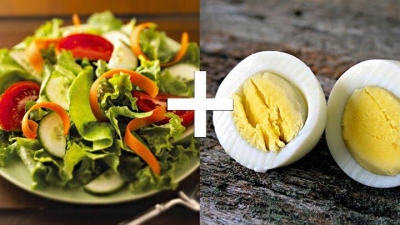
- Surplus grilled tuna or salmon
If you have leftover salmon or tuna from a dinner party, use it as the basis for a tasty salad. In a large bowl, combine 350g cooked tuna or salmon, a 420-g can cannellini beans, 3 thinly sliced spring onions, 2 tablespoons flat-leaf parsley, 1 crushed garlic clove and 1/4 cup (60ml) Italian dressing. Toss thoroughly and enjoy!
- A long life for extra veg
Save all leftover vegetables for up to a week. Dice them; lightly sauté the mixture in olive oil with savoury seasonings such as oregano, basil and black pepper. Add some leftover rice or other grains. Use as filling for a quiche or to fortify a mince-based dish.
- Get a head start on gravy
Did you know that you can whirl almost any kind of leftover soup that has no bones, in a blender or food processor to make a quick sauce or gravy for vegetables or meat?
Add leftover corn kernels to a jar of spicy salsa or pickle. Stirring in corn will not only make it look more colourful but will also tone down an accompaniment that is too hot for your taste.
Don’t throw out unused porridge left in the pan when breakfast is finished. Instead, add it to batter when making muffins. Add the baking powder, eggs and other ingredients as the recipe directs and you may find you like the result.
- Overripe fruit = great smoothies
Don’t relegate overripe fruit to the compost or bin. Freeze it and use the frozen bananas, strawberries and peaches to make a delicious smoothie with yogurt or your liquid of choice. These smoothies may even taste better, thanks to the concentrated sugars in overripe fruit.
- Leftover wine makes great salad dressings
Don’t pour leftover red or white wine down the sink. Put it in an airtight jar and store it in the fridge. When it’s time to make vinaigrette, you can combine the wine in equal quantities with vinegar for a dressing with extra punch.
If a little bit of pinot grigio or chardonnay remains in the bottle at the end of a party or meal, don’t let it go to waste. Pour it into an ice-cube tray and the next time you’re making a sauce, casserole, soup or risotto that calls for a splash of white or red wine, you’ll have it to hand. The cube will melt very quickly, so no defrosting is required.
- Use red wine to tenderize meat
If you have some leftover red wine, put it to work as a meat tenderizer and marinade. Simply put the meat in a self-sealing bag or lidded container and pour the leftover wine over it. Whether grilled or fried, the meat on the plate will have a juicy, tender texture.
If you have lots of chicken, ham or turkey left over, there’s no need to let it go to waste; make your own tasty croquettes. Mince the leftover meat or poultry very finely to make around 450g, add a tablespoon or two of prepared white sauce and a beaten egg, shape into tightly packed, small logs and refrigerate for an hour. Remove the croquettes from the fridge, roll them in fine breadcrumbs, heat up a few tablespoons of vegetable oil in a nonstick frying pan, and then lightly fry until golden brown. Perhaps the best bit comes last; if you don’t finish these leftovers, they will freeze perfectly for up to six months.
Turn it into a homemade ragu that’s so good your family will think a professional is in the kitchen. Chop up the leftover meat into small pieces, return it to its sauce, add 2 cups (500ml) red wine and two cans of crushed tomatoes. Blend well, bring to a simmer, cover and continue to cook for 30 minutes.
Credit : Reader's Digest
Picture Credit : Google
 Ingredients : Self-raising flour: 300 gm, Eggs: 6, Mixed vegetables (finely chopped): 5 cups, Cheese (grated): 1 cup Milk as required, Olive oil, Salt to taste
Ingredients : Self-raising flour: 300 gm, Eggs: 6, Mixed vegetables (finely chopped): 5 cups, Cheese (grated): 1 cup Milk as required, Olive oil, Salt to taste












